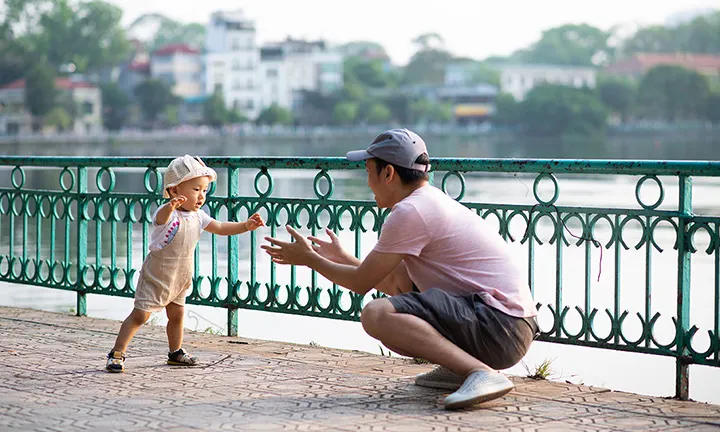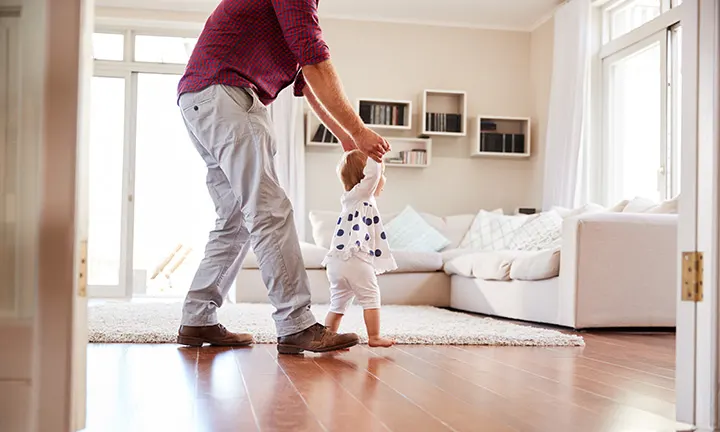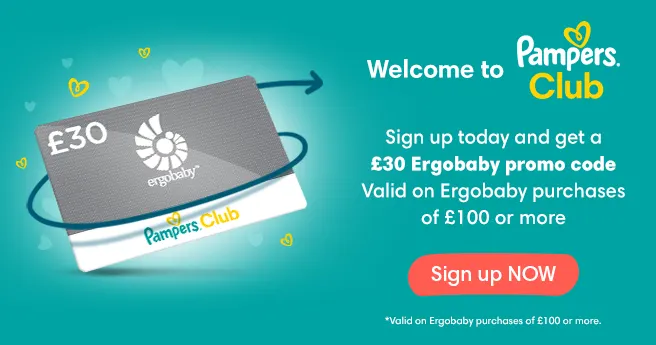When Do Babies Start Walking?
When do babies walk? Your baby’s first steps are an unforgettable milestone, so it’s no surprise if you’re eager to know the answer to this question.
Read on to learn to recognise the signs of readiness, how to encourage those first few tentative steps and how to create a safe environment for your child to toddle and walk in.
When Will Your Baby Start Walking?
Seeing your baby take those first steps is something you’ll remember forever, but exactly when your own little one makes the exciting transition to true ‘toddlerhood’ is anyone’s guess.
So when do babies walk on average? Well, babies can start walking from as early as 10 months to as late as 18 months old, but it can vary a lot, so don’t worry if your baby takes a little longer to get the hang of walking than you’d expected.
Your little one won’t just learn to walk from one moment to the next. Instead, the first year or so of his or her life will be given over to developing the motor skills and muscle strength needed to do things like roll over, crawl, sit up, pull him or herself up and stand in order to eventually walk.
Gaining the physical strength and learning all of these skills takes time, so be patient with your little one. He or she will get there soon enough, and then you won’t be able to hold him or her back!
Stages of Learning to Walk
Here are some skills that need to be developed in the lead up to your baby starting to walk:
Rolling over. Your baby may start learning how to roll from front to back and from back to front by around 6 months old, [] though sometimes it can happen a little earlier. Precisely when your child masters this skill varies a lot, and it can happen unexpectedly, so always keep an eye – and at least one hand – on your baby when he or she is anywhere up high. Being able to roll over is a sign that your baby is gaining the motor skills and muscle strength that are the building blocks for eventually being able to walk.
Crawling. This is when your baby really starts to gain some independence! Somewhere between 7 and 10 months, most babies start to crawl. Don’t be surprised if you see your little one crawling like a bear, shuffling along on his or her bottom or doing anything else that differs from the classic hands-and-knees crawl. There are many different crawling styles. All of these are perfectly normal, although ‘bottom shuffling’ babies may start to walk later. Keep in mind some babies never learn to crawl and go straight to walking. Giving your little one plenty of tummy time can help develop the muscles and motor skills needed for crawling and other physical actions.
Standing. Eventually your little one will start to pull him or herself up to a standing position. You can encourage your baby to stand by supporting him or her in a standing position from an early age. When you do this, you might notice your little one bouncing up and down on his or her feet. This is helping to strengthen your baby’s leg muscles in readiness for walking. Keep in mind that your child will likely try to pull him or herself up on objects like chairs, the couch, bookshelves and dressers. Double check that everything is baby proofed by securing furniture to the wall or floor as needed so there’s no danger of furniture toppling onto your little one.
First steps. After mastering standing, your baby may start to take some tentative steps, sometimes holding on to your hand for help or ‘cruising’ alongside furniture. This helps your little one build up the confidence and independence needed to take those first teetering steps unassisted. Don’t forget to keep your phone or camera near at hand if you’re hoping to record that magical moment!
Signs Your Baby Could Be Ready for Those First Steps
By around 1 year old, your baby is likely to be crawling quite confidently. Around this time, you might see signs that your baby will walk soon, including pulling him or herself up to a standing position, crouching and bouncing, standing, and cruising while holding onto furniture.
When cruising, instead of holding on with both hands and stepping sideways, your baby might drop one hand and turn to walk forwards. This is a common sign that your toddler is nearly ready to let go with the other hand and start walking independently. Seeing this is a sign that your little one is really getting the hang of it and is nearly there!
How to Encourage Your Baby to Walk
To help encourage your baby to start walking, here are some ideas:
Give your toddler a push-along toy like a trolley or cart. A heavier, wooden toy may be more stable and offer more support than a lightweight plastic one. It’s important to closely supervise this kind of play.
If your baby is standing and holding onto a piece of furniture, like a sofa, place a favourite toy on the sofa and move it just out of reach to encourage your little one to move toward it.
Hold your baby’s hands as he or she takes a few steps. After getting used to this, your little one may soon build up enough confidence to let go with one, and eventually both hands.
Give your baby plenty of opportunities to safely cruise while holding on to stable pieces of furniture. Encourage him or her to move between pieces of furniture that are close together.
Try passing toys to your baby from behind while he or she is standing at a piece of furniture. This helps your child get used to letting go with one hand to take the toy.
Singing a clapping song like ‘If you’re happy and you know it...’ could also encourage your baby to let go of whatever he or she is holding onto for support. Exercises like this help develop your toddler’s sense of balance.
Creating a Safe Environment
Now that your baby is learning to walk, take another look at your home to make sure it’s baby proofed for this new stage in your child’s development.
Here are a few tips to consider when baby proofing your home at this time:
Keep your baby’s exploratory area free from sharp furniture corners and trip hazards. For example, add corner guards and roll up any rugs or secure them with non-slip underlay
Install a baby gate at the top and bottom of any stairs, and at any other entryways that are out of bounds for your little one
Carefully secure any freestanding furniture like bookshelves and chests of drawers to the wall, to eliminate any danger of them toppling over if your child pulls him or herself up on them
Move low furniture away from windows, and fit windows with safety catches that stop them opening more than 6.5 centimetres
Add child proof locks to any cupboards or drawers that he or she will be able to reach once able to stand or walk.
When Can Babies Use a Walker?
Despite the name, using a baby walker is generally not recommended for three main reasons:
Baby walkers can be unsafe
They don’t help your baby learn to walk, and may even delay walking
They can exercise the wrong muscles in your baby’s legs, which might lead to foot and ankle problems later.
If you do use a baby walker, experts advice limiting time in the walker to 10 minutes a day. Always supervise your little one closely when in the walker and make sure it is adjusted so that your baby can place both feet flat on the floor when seated in it.
When Should Babies Wear Shoes?
To ensure healthy foot development it’s advisable to hold off buying that first pair of shoes until your baby is walking confidently. Even then, your toddler only needs to wear them when walking outside.
When you buy that first pair of shoes for your baby, it’s best to have them fitted professionally. A shoe shop that specialises in children’s footwear may be able to provide this service. If in doubt, ask your health visitor what options are available locally.
Shoes made from natural materials like leather, cotton or canvas, and choosing socks with a high natural fibre content, are best for letting your baby’s feet breathe properly. This helps prevent fungal infections.
Ideally, a toddler’s shoes should have a fastening to make sure they’re securely fitted to the foot – laces are good, but you might find a buckle or hook-and-loop fastener easier to manage.
During this time, your baby’s feet will grow very fast, so the first pair may only last about two to four months. Check the fit every month or so to see if a bigger size is needed. This is important to make sure that your baby’s soft, developing bones have enough room to grow healthily.

Is Your Baby Walking Properly?
Once your baby starts walking, you might wonder whether he or she is developing the right gait and stance. In the early stages of learning to walk, babies often take ‘waddling’ steps with their feet quite far apart.
This is perfectly normal – your little one is just getting the hang of balancing without any other support. Look mum and dad, no hands!
Besides this early unsteadiness, there are some common minor foot problems that might make you wonder if your baby is walking ‘properly’. Most of these are nothing to worry about and usually correct themselves without treatment (but of course, it’s always OK to discuss any concerns with your health visitor or doctor).
These minor problems when first learning to walk can include:
Tiptoe walking. Walking on tiptoes is another common trait in babies younger than 3 years old. Most children grow out of it, but if your toddler is still doing it after the age of 3, see a doctor to rule out (or diagnose and treat) any underlying cause.
Flat feet. It’s a common myth that flat feet – when there isn’t a pronounced arch between the heel and the base of the big toe – is abnormal in children. In fact, most children between 1 and 5 years old have ‘flat feet’, and 95 percent of them will grow out of it by the age of 6. Even if they persist, flat feet won’t usually cause any problems for your child in later life.
In-toeing. Sometimes called ‘pigeon toes’, this is where your toddler’s feet point inwards. It usually clears up by itself by the time your child is 8 or 9 years old.
Out-toeing. As the name suggests, this is the opposite of in-toeing, with the feet pointing outwards. Just like with in-toeing, treatment isn’t usually needed and it will usually correct itself with time.
Bow legs. Most children can seem a little bow-legged – with a small gap showing between the knees and ankle – until they are around 2 years of age. Check with your health visitor or doctor if it seems very pronounced or doesn’t correct itself after this age.
Knock knees. When your baby stands with his or her knees together, a gap of up to around 6 centimetres between the ankles is nothing to worry about between 2 and 4 years old. It usually corrects itself by the age of 6 years.
When to See the Doctor
Babies develop at different rates – the age at which your little one takes those first baby steps can be anything between 10 and 18 months old.
Babies develop at different rates – the age at which your little one takes those first baby steps can be anything between 10 and 18 months old.
Weak, floppy or stiff arms or legs
Strongly favouring one side of the body, for example only using one arm or leg, or always turning the head to one particular side
Inability to put one or both feet flat on the floor
Problems with vision or hearing.
FREQUENTLY ASKED QUESTIONS
Babies develop at their own pace and start walking when they’re good and ready, but you can help and encourage them to take those first baby steps by
- giving your baby a push-along toy like a trolley or cart
- placing a favourite toy just out of reach when your little one is standing holding onto a sofa or other piece of furniture
- holding your baby’s hands as he or she takes a few steps
- giving your baby plenty of opportunities to safely cruise while holding on to stable pieces of furniture
- encouraging your baby to let go with one or both hands when standing at a piece of furniture, for example by offering a toy or singing a clapping song like ‘If you’re happy and you know it...”.
The Bottom Line
Seeing your baby take those first steps can be one of the happiest moments in your parenthood journey, but of course it may also be a little nerve-racking seeing your baby start to toddle and explore the world using this new skill for the first time.
Let your baby learn to walk at his or her own pace in a safe environment, and both you and your toddler (and everyone else in your household and family) will soon get used to your little one’s new-found independence.
If you have any concerns at all, turn to your health visitor or doctor for advice.
How we wrote this article
The information in this article is based on the expert advice found in trusted medical and government sources, such as the National Health Service (NHS). You can find a full list of sources used for this article below. The content on this page should not replace professional medical advice. Always consult medical professionals for full diagnosis and treatment.
Join Pampers Club and get:





